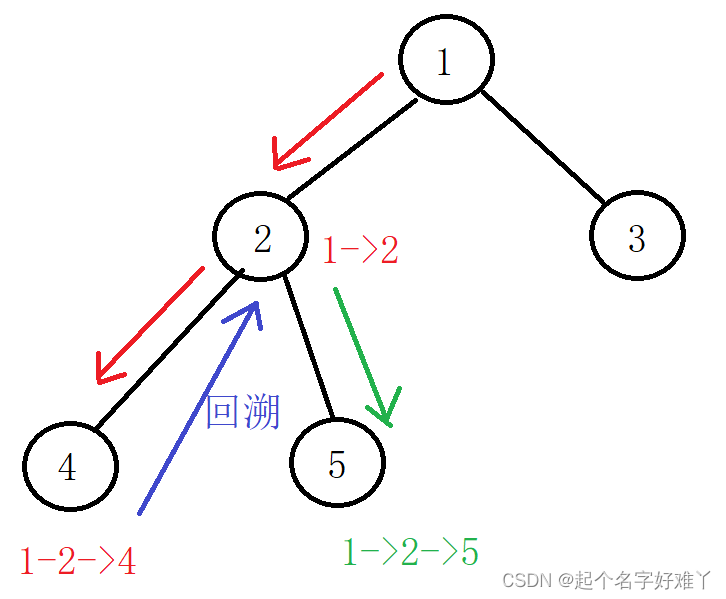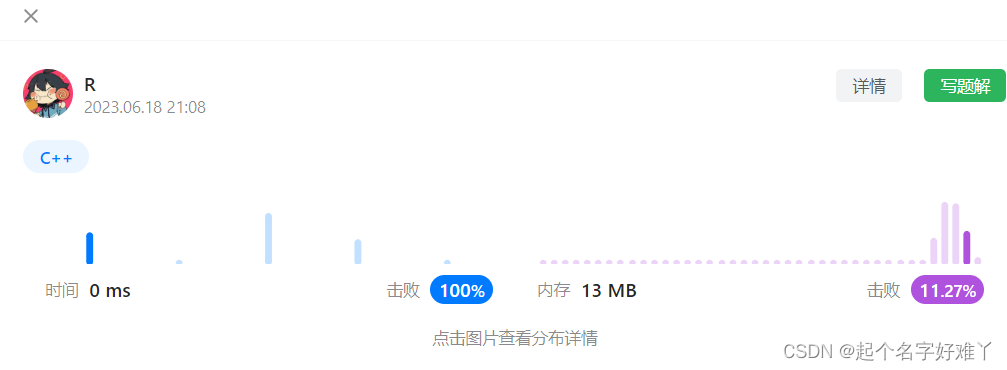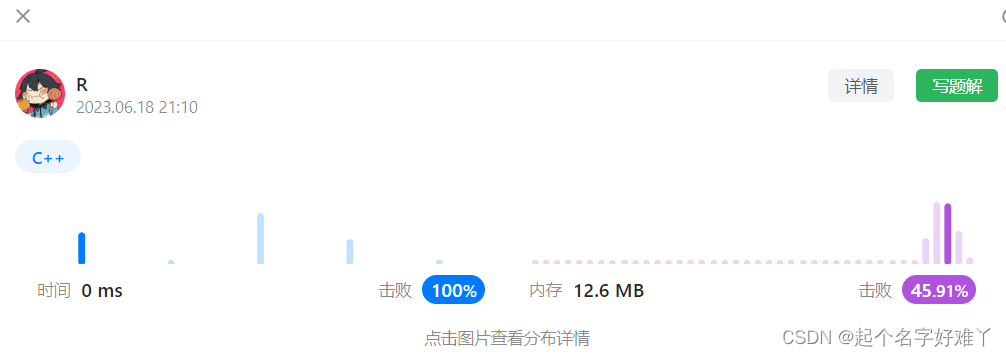写在前面:
题目链接:LeetCode257. 二叉树的所有路径
题目难度:简单
编程语言:C++
一、题目描述
给你一个二叉树的根节点 root ,按 任意顺序 ,返回所有从根节点到叶子节点的路径。
叶子节点 是指没有子节点的节点。

输入:root = [1,2,3,null,5]
输出:[“1->2->5”,“1->3”]
示例 2 :
输入:root = [1]
输出:[“1”]
二、题目分析&解题思路
由于是从回溯法里找了一道题,那么就话不多说直接上回溯
如果之前没有了解过回溯的可以先看看回溯的思路:

如果还是不太理解的话,可以参考下面这篇博客:
LeetCode.46. 全排列(回溯法入门)
不过每个节点的值需要从 int 转到 string
刚开始不知道 C++ 里面有专门 Int To string 的方法(大傻子本人了)
然后自己啥没写,先自己手写了一个 Int To string 的方法,感觉太傻了,各位献丑了:
vector<string> vctMap = {"0","1","2","3","4","5","6","7","8","9"};string IntToStr(int val){if(val >=0 && val < 10){return vctMap[val];}else if(val>-10 && val <0){val = -val;string strResult = "-" + vctMap[val];return strResult;}else {bool isFushu = false;if(val < 0){isFushu = true;val = -val;}//开始取每一位string strResult = "";while( val > 0){int temp = val%10;strResult.insert(0,vctMap[temp]);val/=10;}if(isFushu){strResult.insert(0, "-");}return strResult;}}
然后下面才是回溯的代码:
//回溯函数void back(TreeNode* root, string strPath){//终止条件if(root->left == nullptr && root->right == nullptr){vctResult.push_back(strPath);return;}//不断向递归终止条件逼近//左if(root->left != nullptr){string strTemp = "->"+IntToStr(root->left->val);strPath+=strTemp;back(root->left, strPath);//回溯 也就是把上一次的结果删除掉strPath.resize(strPath.size() - strTemp.size());}//右if(root->right != nullptr){string strTemp = "->"+IntToStr(root->right->val);strPath+=strTemp;back(root->right, strPath);//回溯strPath.resize(strPath.size() - strTemp.size());}}
三、完整代码
class Solution {
public:
vector<string> vctResult;
string strPath = "";
vector<string> vctMap = {"0","1","2","3","4","5","6","7","8","9"};
public://自己傻傻写的int to string 函数string IntToStr(int val){if(val >=0 && val < 10){return vctMap[val];}else if(val>-10 && val <0){val = -val;string strResult = "-" + vctMap[val];return strResult;}else {bool isFushu = false;if(val < 0){isFushu = true;val = -val;}//开始取每一位string strResult = "";while( val > 0){int temp = val%10;strResult.insert(0,vctMap[temp]);val/=10;}if(isFushu){strResult.insert(0, "-");}return strResult;}}//回溯函数void back(TreeNode* root, string strPath){//终止条件if(root->left == nullptr && root->right == nullptr){vctResult.push_back(strPath);return;}//不断向递归终止条件逼近if(root->left != nullptr){//保存每个路径上的节点值string strTemp = "->"+IntToStr(root->left->val);strPath+=strTemp;back(root->left, strPath);//回溯strPath.resize(strPath.size() - strTemp.size());}if(root->right != nullptr){//保存每个路径上的节点值string strTemp = "->"+IntToStr(root->right->val);strPath+=strTemp;back(root->right, strPath);//回溯strPath.resize(strPath.size() - strTemp.size());}}vector<string> binaryTreePaths(TreeNode* root) {if(root == nullptr){return vctResult;}else{//先开始把根节点加上strPath = IntToStr(root->val);back(root, strPath);return vctResult;}}
};
运行结果:

我们再使用c++ 自己的to_string 接口试试:
/*** Definition for a binary tree node.* struct TreeNode {* int val;* TreeNode *left;* TreeNode *right;* TreeNode() : val(0), left(nullptr), right(nullptr) {}* TreeNode(int x) : val(x), left(nullptr), right(nullptr) {}* TreeNode(int x, TreeNode *left, TreeNode *right) : val(x), left(left), right(right) {}* };*/
class Solution {
public:
vector<string> vctResult;
string strPath = "";
public://回溯函数void back(TreeNode* root, string strPath){//终止条件if(root->left == nullptr && root->right == nullptr){vctResult.push_back(strPath);return;}//不断向递归终止条件逼近//向左if(root->left != nullptr){string strTemp = "->"+to_string(root->left->val);strPath+=strTemp;back(root->left, strPath);//回溯 也就是把上次的结果删除掉strPath.resize(strPath.size() - strTemp.size());}//向右if(root->right != nullptr){string strTemp = "->"+to_string(root->right->val);strPath+=strTemp;back(root->right, strPath);//回溯strPath.resize(strPath.size() - strTemp.size());}}vector<string> binaryTreePaths(TreeNode* root) {if(root == nullptr){return vctResult;}else{//先开始把根节点加上strPath = to_string(root->val);back(root, strPath);return vctResult;}}
};
运行结果:



